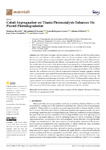Mostrar o rexistro simple do ítem
Cobalt Impregnation on Titania Photocatalysts Enhances Vis Phenol Photodegradation
| dc.contributor.author | Belekbir, Soukayna | |
| dc.contributor.author | El Azzouzi, Mohammed | |
| dc.contributor.author | Rodríguez-Lorenzo, Laura | |
| dc.contributor.author | El Hamidi, Adnane | |
| dc.contributor.author | Santaballa, J. Arturo | |
| dc.contributor.author | Canle, Moisés | |
| dc.date.accessioned | 2023-10-26T17:44:34Z | |
| dc.date.available | 2023-10-26T17:44:34Z | |
| dc.date.issued | 2023-06-01 | |
| dc.identifier.citation | Belekbir, S.; El Azzouzi, M.; Rodríguez-Lorenzo, L.; El Hamidi, A.; Santaballa, J.A.; Canle, M. Cobalt Impregnation on Titania Photocatalysts Enhances Vis Phenol Photodegradation. Materials 2023, 16, 4134. https://doi.org/10.3390/ma16114134 | es_ES |
| dc.identifier.issn | 1996-1944 | |
| dc.identifier.uri | http://hdl.handle.net/2183/33939 | |
| dc.description | This article belongs to the Special Issue Advanced Catalysts for Energy and Environmental Applications | es_ES |
| dc.description.abstract | [Abstract] One of the main challenges of photocatalysis is to find a stable and effective photocatalyst, that is active and effective under sunlight. Here, we discuss the photocatalytic degradation of phenol as a model pollutant in aqueous solution using NUV-Vis (>366 nm) and UV (254 nm) in the presence of TiO2-P25 impregnated with different concentrations of Co (0.1%, 0.3%, 0.5%, and 1%). The modification of the surface of the photocatalyst was performed by wet impregnation, and the obtained solids were characterized using X-ray diffraction, XPS, SEM, EDS, TEM, N2 physisorption, Raman and UV-Vis DRS, which revealed the structural and morphological stability of the modified material. BET isotherms are type IV, with slit-shaped pores formed by nonrigid aggregate particles and no pore networks and a small H3 loop near the maximum relative pressure. The doped samples show increased crystallite sizes and a lower band gap, extending visible light harvesting. All prepared catalysts showed band gaps in the interval 2.3–2.5 eV. The photocatalytic degradation of aqueous phenol over TiO2-P25 and Co(X%)/TiO2 was monitored using UV-Vis spectrophotometry: Co(0.1%)/TiO2 being the most effective with NUV-Vis irradiation. TOC analysis showed ca. 96% TOC removal with NUV-Vis radiation, while only 23% removal under UV radiation. | es_ES |
| dc.description.sponsorship | This research received support through grant TED2021-132667B-I00, funded by the EU NextGenerationEU/PRTR through project MCIN/AEI/10.13039/501100011033. Financial support was also provided by the regional government Xunta de Galicia through project GPC/ED431B 2020/52. S.B. thanks the KA-107 grant received from the EU through the Erasmus+ program for a research stay at UDC | es_ES |
| dc.description.sponsorship | Xunta de Galicia; ED431B 2020/52 | es_ES |
| dc.language.iso | eng | es_ES |
| dc.publisher | MDPI | es_ES |
| dc.relation | info:eu-repo/grantAgreement/AEI/Plan Estatal de Investigación Científica y Técnica y de Innovación 2021-2023/TED2021-132667B-I00/ES/ | es_ES |
| dc.relation.uri | https://doi.org/10.3390/ma16114134 | es_ES |
| dc.rights | Atribución 4.0 Internacional | es_ES |
| dc.rights.uri | http://creativecommons.org/licenses/by/4.0/ | * |
| dc.subject | Photocatalysis | es_ES |
| dc.subject | Phenol | es_ES |
| dc.subject | Cobalt | es_ES |
| dc.subject | Oxygen vacancies | es_ES |
| dc.subject | UV-Vis radiation (366 nm) | es_ES |
| dc.subject | UV (254 nm) | es_ES |
| dc.subject | TiO2-P25 | es_ES |
| dc.subject | Wet impregnation | es_ES |
| dc.subject | SERS | es_ES |
| dc.title | Cobalt Impregnation on Titania Photocatalysts Enhances Vis Phenol Photodegradation | es_ES |
| dc.type | info:eu-repo/semantics/article | es_ES |
| dc.rights.access | info:eu-repo/semantics/openAccess | es_ES |
| UDC.journalTitle | Materials | es_ES |
| UDC.volume | 16 (2023) | es_ES |
| UDC.issue | 11 | es_ES |
| UDC.startPage | 4134 | es_ES |
| dc.identifier.doi | 10.3390/ma16114134 |
Ficheiros no ítem
Este ítem aparece na(s) seguinte(s) colección(s)
-
GI-REACT! - Artigos [103]






